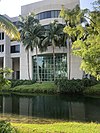Miami Project to Cure Paralysis
| Founded | 1985 |
|---|---|
| Founder | Nick Buoniconti and Barth A. Green |
| Type | Medical |
| Focus | Spinal cord injury and brain damage |
| Location |
|
| Coordinates | 25°47′18.74″N 80°12′44.57″W / 25.7885389°N 80.2123806°W |
Area served | Global |
| Owner | University of Miami |
Key people | Marc A. Buoniconti, President W. Dalton Dietrich, Scientific Director Suzanne M. Sayfie, Executive Director Diana C. Berning, Administrative Director[1] |
Revenue | $23 million[2] |
| Employees | 250[3] |
| Website | www |
The Miami Project to Cure Paralysis is a spinal cord injury research center and a designated Center of Excellence at the University of Miami's Miller School of Medicine in Miami, Florida.
The Miami Project was co-founded in 1985 by Barth A. Green and Pro Football Hall of Fame linebacker Nick Buoniconti after Buoniconti's son, Marc, sustained a spinal cord injury during a college football game. The Miami Project's international team is housed in the Lois Pope LIFE Center and includes more than 250 scientists, researchers and clinicians.
Clinical trials
[edit]In July 2012, The Miami Project was granted approval by the U.S. FDA to proceed with a Schwann cell implantation clinical trial. In November 2012, doctors from the University of Miami implanted the first patient with his own Schwann cells, initiating phase 1 of the trial, a test of the safety and efficacy of the technique.[4][5]
Buoniconti Fund
[edit]The Buoniconti family established The Buoniconti Fund to Cure Paralysis in 1992, a non-profit organization devoted to assisting The Miami Project.
Lois Pope LIFE Center
[edit]The center is located in the Schoninger research quadrangle at the University of Miami's Jackson Memorial Medical Center. It was named in honor of Lois Pope, who donated $10 million toward its construction, and of her charity Leaders in Furthering Education (LIFE).
The building opened on October 26, 2000. Pope's gift also funds 20 LIFE Fellows for neurological research.[6][7] The six-story 180,000 sq ft (17,000 m2) building cost $28 million and was designed by MGE Architects.[8] The block of Northwest 11th Avenue in Miami in front of the building has been named Buoniconti Drive.[9]
References
[edit]- ^ "Management and Faculty". Univ. of Miami. Archived from the original on 2010-12-21. Retrieved 2011-01-18.
- ^ "Message from the President". Univ. of Miami. Archived from the original on 2011-06-13. Retrieved 2011-01-18.
- ^ "Message from the Chairman". Univ. of Miami. Archived from the original on 2010-12-21. Retrieved 2011-01-18.
- ^ "Clinical Trials Initiative Update". Archived from the original on February 13, 2012. Retrieved September 23, 2017.
- ^ "FDA Gives Miami Project Green Light for Phase 1 Clinical Trial". TheMiamiProject.org. July 31, 2012. Retrieved September 23, 2017.
The Miami Project to Cure Paralysis, a Center of Excellence at the University of Miami Miller School of Medicine, has received permission from the Food and Drug Administration (FDA) to begin a revolutionary Phase 1 clinical trial to evaluate the safety of transplanting human Schwann cells to treat patients with recent spinal cord injuries.
- ^ "The Lois Pope LIFE Center Will Be Top Neurological Research Facility In The World". LIFE. Archived from the original on 2010-12-08. Retrieved 2011-01-18.
- ^ "Lois Pope LIFE Center". Univ. of Miami. Archived from the original on 2011-07-16. Retrieved 2011-01-18.
- ^ "Lois Pope Life Center". Total Systems Commissioning, Inc. Archived from the original on 2011-07-28. Retrieved 2011-01-18.
- ^ "Maps and Directions". Univ. of Miami. Archived from the original on 2011-05-24. Retrieved 2011-01-18.

